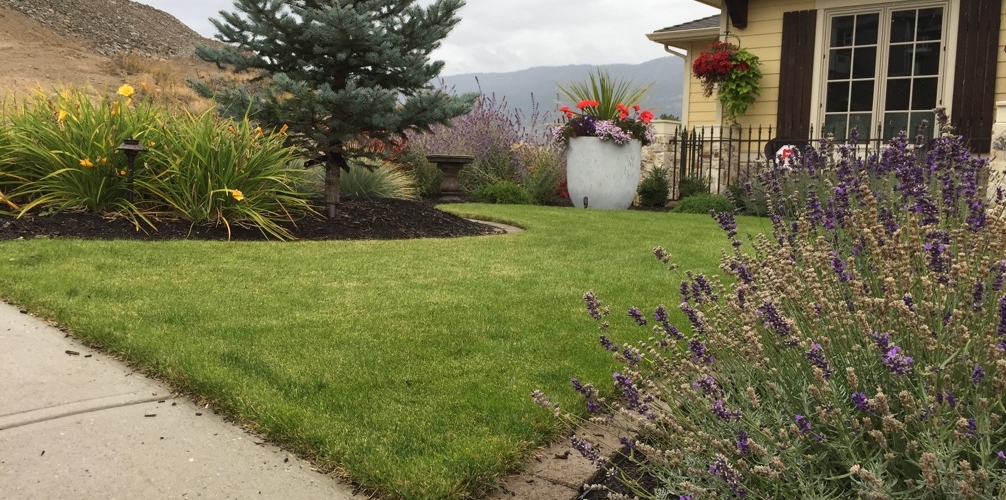
BLOG
NOKOMIS LANDSCAPING
Landscape Design Tips: Front Yard Curb Appeal
Your home's front yard landscaping plays an important role in setting the tone not only for curb appeal, but also for how your property should be valued and perceived. A good design can also indicate the type of family that lives in the home and how they feel about the home they dwell. Elements of landscape design can showcase the home itself and set it apart from other homes in your neighborbood. A home with a good balance of plant beds to lawn areas, with a good palette of colour and seasonal interest will create a more attractive property than simply covering your front landscaping with a lawn area and a tree.
Investing in curb appeal, especially initially for a new build will pay off in added value for a future list price, as well as sell a home sooner.
Some items to look at that will help with your front yard:
- Overall Design.
The design should have some interest. All lawn with a corner bed to include a tree and a mug pine is not interesting. If the size of your front yard is large enough and level, lawn will look good here. A good balance of lawn area to plant beds is about 60/40 or 50/50. The lawn should be shaped around natural slopes and tree locations. The plant beds you remain with should feature a thoughtful planting scheme that look at most of the following: balance, form, texture, colour, repetition, height with a mix of deciduous and coniferous. These areas should be planted to meet the style you are aiming for, and be planted with size requirements at maturity of all plants. Plants should soften and shelter the view of the home, yet not screen or block it.
2. Focal Point.
I like to plan for an item in every front yard that draws you in. Whatever is chosen should meet with the style of the home and/or personality of the owners. A simple concrete address wall placed toward the street of a contemporary home will both identify the address of the home, and tie in nicely with the architectural features of the house. A tiered fountain on display in a key area of a tuscan/mediterranean style home both adds an element of water and noise and meets the style of the home. A decorative post and rail fence flanking both sides of e front yard of a craftsman style house, stained to match the trim of the home will always look suitable. A simple option may be simply a bright red 3' tall urn placed in the centre of plant bed. The focal point is usually the first thing going through my mind when looking at the front of a new client's home.
3. Entry.
Accessing the home is important. What you decide to use for the driveway is one thing, but the adjoining pathway to the front door should be emphasized. Typically a builder will simply prep and pour an exposed aggregate driveway with an extended curved surface 4' wide to meet the front door. This is an easy approach and keeps a consistent look for the surfacing out front. Adding a selection of pavers or alternative concrete surfacing will set the entry apart from the driveway. Making this area wider than normal as well will identify the walkway and make a bit more of a statement as guests approach and enter your home. Year to year more options emerge for pavingstones, with many options for different styles of homes.
4. Landscape Lighting.
Lighting is a nice touch which will extend your curb appeal into the evening hours, add a bit more security and showcase those focal points in the landscape design and emphasize the architectural features of your home that you are proud of. LED lighting transformers nowadays offer dimming and color changing capabilities that allow owners to set a different mood with lighting based on the season or calendar date. Uplighting, and area lights for your driveway lights offer a different element to landscape design.
5. Ongoing Maintenance.
Caring for your yard is vital to keeping your curb appeal long lasting. A trimmed, fertilized lawn and cared for plants will indicate how you treat your investments, and value your belongings. Regular maintenance will ensure items in your yard develop properly and last longer. Having an arborist in to inspect your trees every 5 years for instance will ensure the longevity of the tree and proper growth habits. Irrigation check-ups and service work every 2-3 years will ensure the watering of your lawn occurs when it should and how it was intended to. All these items add up to maximizing both the value of your property and the length of its life span.
By Michael Arding, owner/designer of Nokomis Landscaping
The Importance of Planning for your Project’s Landscaping
Hiring a contractor for a new project can be stressful. There are a lot of decisions to factor in before giving someone control of your project.
- How much will your project cost?
- What is included in the project costs?
- Where should the pool be placed to maximize other needs in the backyard?
- Is the seating area sufficient in size?
- What would an alternative shape or size look like?
- How will the placement of a large tree effect your view?
These are all examples of questions that could arise in the process.
Having a landscape plan prepared prior to making an important commitment will provide for many benefits that will ensure you maximize the investment in your property. Benefits of a landscape plan can include:
- Allow for a detailed illustration of what things will look like
- Identify areas of the project that are to be included in a contract with your contract. Perhaps there are some items on the plan that are easy enough for the homeowner to organize on their own time. Like a vegetable garden or fencing.
- Allow you to show an option 'B' or 'C' for consideration.
- A future reference for plantings.
- A designer can plan for the future. Phases can be identified. Perhaps a patio or pergola that is not in the budget now, but is desirable 5 years from now can be planned for in present time.
- Comparative quotations. A specific plan that you can distribute to 2 or 3 contracts will allow you to compare quotes on an even keel. Without a plan it would be difficult to compare one quote to the next. Most contractors have different visions and installation methods. Make note of details on a contractor's quote?
- Specifics. A designer can recommend the ideal depth of soil beneath soil for example. Or, the base preparation required for a paving stone driveway installation on an existing clay based soil. Or a grouping of flowering shrubs that will grow nicely in a shady location with deer that inhabit the area.
- Landscape Lighting is easy to plan for on paper. To clearly mark and identify lighting locations on a scaled drawing is easier than in the field.
For me, any project over $5,000 warrants a detailed plan up front. Anything less can likely be identified on site between the contractor and homeowner with the use of measuring tools and marking paint. The landscape plan process could take 1-3 weeks. A well-referred contractor may take 2-4 months to be able to accommodate your installation. So lead time is key to preparing details for your project. The fall/winter months tend to be a good time to look at this area of your property.
Fees for a landscape plan will differ from designer to designer. But for most new builds on typical homesites can cost from $600-1,200 for a descriptive plan. Some designers even offer incentives or discounts for plans when their company's install crews are hired for the work. Most Landscape Designers start around $60/hr and can be as high as $100/hr. Designers can also show your plan in color, or render portions in 3D if required.
Ask your prospective designer to show you past plans for a similar sized property and identify costs associated. This will allow you to get a good estimate of what you may spend, and show the level of detail included. Perhaps there are specific details that can be avoided to save a bit of money as well. Having the designer simply show the plant material, but not label it would avoid a couple hours of design time.
Having a $15,000 budget and handing those funds to a contractor and just hoping you get all the things you want out of your yard can be very risky. Corners can easily be cut by the contractor. Depth of soil could be cut in half. Smaller plants could get installed. Wrong locations could be chosen for large trees. Cheaper pavers might be sourced. Or perhaps certain areas of the project are assumed to be not included in the contract price.
Explore options with local designers in your area.
By Michael Arding, owner/designer of Nokomis Landscaping




